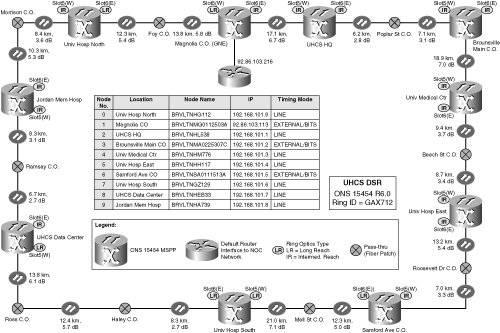MSPP Network Design Case Study
| A major healthcare services provider in a large metropolitan area is currently preparing to implement a major upgrade to its data and telecommunications networks. Backbone connectivity for University Healthcare System, Inc. (UHCS), in Brounsville is currently provided using multiple T1, DS3, and OC-3 links provided by a local exchange carrier, BrounTel. These leased lines are used for connectivity among various company locations, such as the corporate headquarters campus and various hospital locations throughout the metro area. These services are provisioned through a combination of BrounTel copper T1 span lines, legacy point-to-point asynchronous optical multiplexers, and first-generation SONET OC-3 and OC-12 systems. The company is seeking to upgrade its current network services for several reasons:
After discussing service requirements and contract terms with BrounTel, the IT managers have elected to contract with BrounTel to provide a leased dedicated SONET ring (DSR) service for connectivity between company sites, and for access to the public switched telephone network (PSTN). BrounTel will deploy a Cisco ONS 15454 MSPP solution for the DSR. MSPP Ring Network DesignA total of seven sites in various parts of the metro area will need connectivity to the new network. BrounTel has existing standard single-mode fiber (SMF) optic cables serving some of the locations; it will use existing cable or build new optical cable facilities as required for diverse routing between the company locations and multiple BrounTel central offices. Three central office locations will have MSPP nodes on the SONET ring; the others will serve as fiber patch (or pass-through) locations. Table 6-8 gives a list of location names, addresses, and site types.
Table 6-9 shows the measured (for existing facilities) or calculated (for proposed facilities) fiber cable loss figures for the ring facilities. All loss figures include losses because of splices, connectors and patch panels, as well as the cable loss.
Because of the relatively short distances between MSPP node locations, polarization mode dispersion (PMD) will not be an issue in this deployment. To determine the bandwidth requirements for the ring, the UHCS service demands must be considered. These services will be provided using the DSR:
Listing the requirements individually, take a look at Table 6-10, which shows the planned circuits for the ring.
To calculate the bandwidth requirements for the ring, simply add each of the individual requirements to arrive at the total number of STS-1s needed. This calculation is shown in Table 6-11.
Note The GigE links that form the RPR reuse the same bandwidth throughout the ring because they are built without SONET protection. Because the initial requirements are 81 STS-1s, an OC-192 ring will be used. This allows sufficient capacity for the existing service requirements, as well as for future growth to the network. OC-192 Ring Transmission DesignHaving defined the network bandwidth requirements to be OC-192, you can now select the appropriate OC-192 interfaces to equip at each ONS 15454 MSPP node to link the ring sites. ONS 15454 OC-192 IR interfaces transmit at a nominal wavelength of 1550 nm and have an allowable link loss budget of about 13 dB. OC-192 LR interfaces also transmit at the 1550 nm wavelength and have an allowable link loss budget of 26 dB. There is also an available SR OC-192 interface, but the small allowable link loss budget is not suitable for the distances involved in the UHCS application. Therefore, either the IR or LR optics will be used, with 10 dB being the "breakpoint" between the two. This allows 3 dB of margin for future loss increases due to fiber cable degradation, future repair splicing, and component aging. Based on the specifications of the various ONS 15454 OC-192 interfaces and the loss characteristics of each fiber section (outlined in Table 6-9), the node-to-node interface types can be determined for the ring. OC-192/10G operation is allowed in chassis Slots 5, 6, 12, and 13. You use a pair of these slots at each location for the East- and West-facing ring interfaces. Although any combination of two of the four available slots is acceptable, uniformly select Slots 5 and 6 at each of the nodes for operational simplicity. Table 6-12 shows the selection of OC-192 optics for each ring span.
In addition to the optical trunk interface card selection, one of the BrounTel central office nodes will be designated as the Gateway Network Element (GNE) and will connect to BrounTel's Network Operations Center (NOC) using its IP-based interoffice management network. The Magnolia central office MSPP node will be chosen as the GNE. For the purposes of network synchronization, each MSPP node located in a BrounTel central office will be connected to the office BITS and will be configured as externally timed. Line timing will be configured on the ONS 15454 systems located in the UHCS customer premises sites, with the OC-192 optical interface ports on the cards installed in Slots 5 and 6 serving as the primary and secondary reference sources. With all the necessary parameters now defined, you can prepare all necessary engineering documentation, such as the network map, shelf card slot assignments, chassis EIA equipage, tributary protection group configuration, and cabling termination assignments. Network MapThe network map or ring map is a key piece of documentation that assists in bringing an MSPP network online, as well as a future as-built reference for planning, troubleshooting, and performing upgrades or additions. Figure 6-13 shows the network map for the UHCS DSR. The following information has been included:
The node numbers and Ring ID have also been provided as reference information; however, because this is not a BLSR network, this information is not required to provision the ring nodes. Shelf Card Slot Assignments, EIA Equipage, and Tributary Protection Group ConfigurationThe versatility of the ONS 15454 MSPP gives the BrounTel engineers multiple options when selecting the chassis card slot assignments. Some assignments will be common for all ring nodes; others might vary to allow for maximum flexibility to add future services to the network. An important factor in the determination of card slot assignments for electrical interface cards, such as the DS1 and DS3 cards in the UHCS ring, is the type of tributary card protection required. Additionally, these interface types and their locations will help to determine the type of EIA that must be ordered for the ONS 15454 chasses. All 10 of the ring nodes have the TCCP2 cards in Slots 7 and 11. Recall that two TCC cards are required in every ONS 15454 MSPP node. Likewise, two XC-VXC-10G cross-connect cards will be placed in Slots 8 and 10 for each node. Finally, for standardization and operational simplicity, the OC-192 ring interface cards will be placed in Slots 5 (West) and 6 (East) in each of the ring nodes. For the other interface cards required in the ring nodes, customized slot assignments will be specified. According to the conditions of the DSR service contract, BrounTel will design all TDM service interfaces to be card-protected in either 1:1 or 1:N protection groups. Of course, the Ethernet service interfaces will be unprotected. At the University HospitalNorth node (Node 0), the initial service-termination requirements include seven DS1 circuits, three private-line GigE links (one line rate and two subrate), and the GigE RPR circuit connections. Figure 6-14 shows the shelf diagram with card locations for this node. The DS1s require a single working DS1-14 card. This card will be placed in Slot 4, with a DS1N-14 card installed in Slot 3 for protection. A 1:N protection group will be established for these cards, as indicated in the diagram. The use of Slots 3 and 4 will allow for future growth in DS1s; Slots 1 and 2 are left vacant for potential future DS3 requirements. Two G1K-4 cards are required because of the necessity of a line-rate (STS-24c) circuit, and two sub-rate circuits (STS-12c each), whose combined bandwidth exceeds 12 STS-1s. Slots 16 and 17 will be used for these cards. Note that the GBIC types for the ports to be equipped are indicated on the shelf diagram. The "SX" designation indicates that these ports will be equipped with 1000Base-SX (850-nm) GBICs. A single ML-Series card is required to connect this node to the RPR overlay. Because UHCS requires redundant GigE links from this interface, an ML1000-2 card with dual 1000Base-SX SFPs is specified, and this card will be installed in Slot 15. Also, an AIC-I card will be installed in Slot 9 so that, through the SONET overhead, the BrounTel network operations center can monitor the contact closure alarms from the associated direct current (DC) power plant. Card Slots 1, 2, 12, 13, and 14 will not be used for service interfaces initially and will be equipped with blanks. Figure 6-14. University Hospital North NodeShelf Diagram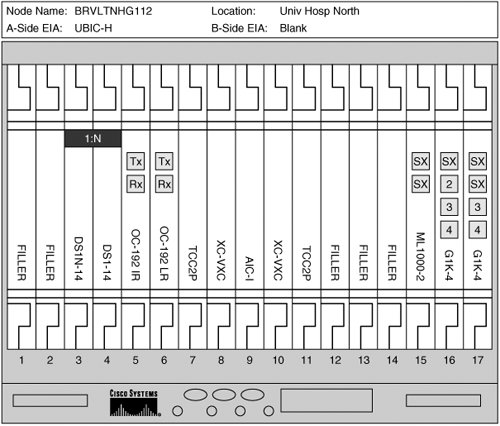 The DS1 interfaces in this node require backplane electrical connections. Because of the requirement for possible future DS3s, a UBIC-H EIA will be installed on Side A of the rear of the chassis. This enables both DS1 and DS3 interfaces to be cabled out from the rear of the shelf. Because all current and future requirements for Side B are front-cabled interface cards (Ethernet, storage, or optical), an EIA is not required to be installed on the rear of Side B, and the default blank cover can be used. Each of the other MSPP nodes in the UHCS ring will be designed using similar interfaces, with an eye on future network-expansion requirements. A brief description of the requirements, interfaces, and protection groups for each is given in the next several sections, along with an accompanying shelf diagram. Magnolia Central Office (Node 1)Requirements are for five DS1s and two DS3s. Both interface types will be slotted on Side B, and a UBIC-H EIA will be equipped on the rear to accommodate the cabling for these cards. See Figure 6-15 for the shelf diagram. Figure 6-15. Magnolia Central Office NodeShelf Diagram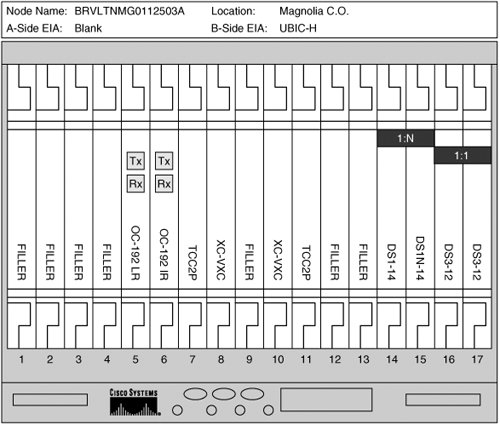 UCHS Headquarters (Node 2)Initial requirements are 44 DS1s, 4 DS3s, 1 line-rate private line Ethernet circuit, and the RPR GigE links. The high-density (56-port) DS1 card will be used on Side B, with the DS3 cards on Side A. Both shelf sides will be equipped with the UBIC-H EIA. See Figure 6-16 for the shelf diagram. Figure 6-16. UCHS Headquarters NodeShelf Diagram Brounsville Main Central Office (Node 3)Requirements are for two DS1s and one DS3. Both interface types will be slotted on Side B, and a UBIC-H EIA will be equipped on the rear to accommodate the cabling for these cards. See Figure 6-17 for the shelf diagram. University Medical Center (Node 4)Initial requirements are for seven DS1s, as well as the RPR GigE links. DS1 interface cards and a UBIC-H EIA will be installed on Side B, with the ML1000-2 card and associated SX SFPs on Side A. See Figure 6-18 for the shelf diagram. Figure 6-17. Brounsville Main Central Office NodeShelf Diagram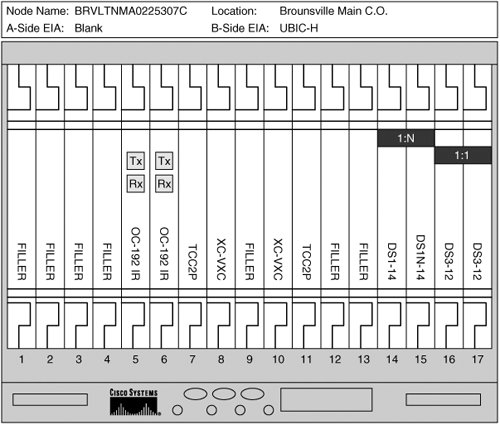 Figure 6-18. University Medical Center NodeShelf Diagram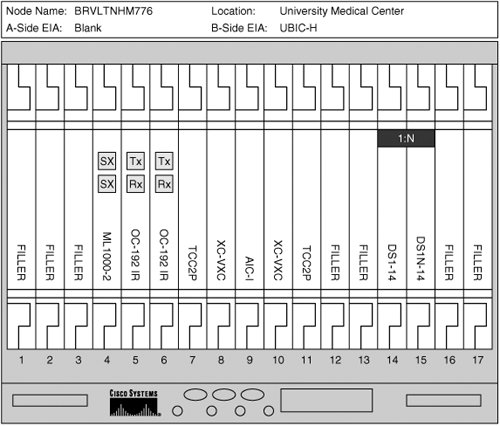 University HospitalEast (Node 5)Five DS1s, a single subrate GigE private line circuit, and the RPR GigE links must be provisioned at this location. A DS1-14 card will be placed in Slot 14 and will be protected by a DS1N-14 card in Slot 15. The Ethernet cards will be installed on the A Side. Because electrical interfaces are required to be cabled only from the B side of the shelf, no EIA will be required to be installed on Side A. See Figure 6-19 for the shelf diagram. Figure 6-19. University HospitalEast NodeShelf Diagram Samford Avenue Central Office (Node 6)Initial requirements are for 22 DS1s and 3 DS3s. A pair of DS1-14 cards will be placed in Slots 16 and 17, with both cards being protected in a 1:N group by a DS1N-14 card in Slot 15. The DS3-12E card will be placed in Slot 2 and will be protected by a DS3N-12E card in Slot 3. UBIC-H EIAs will be installed on the rear for both sides. See Figure 6-20 for the shelf diagram. Figure 6-20. Samford Avenue Central Office NodeShelf Diagram University HospitalSouth (Node 7)Nine DS1s, a subrate (STS-12c) GigE private line connection, and the RPR GigE links are required. See Figure 6-21 for the shelf diagram. Figure 6-21. University HospitalSouth NodeShelf Diagram UCHS Data Center (Node 8)Initial requirements include 14 DS1s, 2 DS3s, and the RPR GigE links. Electrical interfaces will be installed only on Side B. See Figure 6-22 for the shelf diagram. Figure 6-22. UCHS Data Center NodeShelf Diagram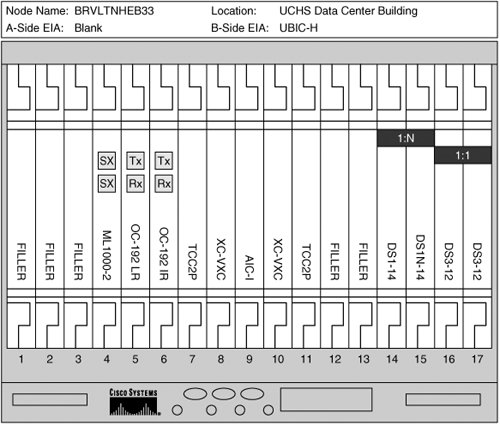 Jordan Memorial Hospital (Node 9)Seven DS1s and the RPR GigE links are the initial requirements here. See Figure 6-23 for the shelf diagram. Figure 6-23. Jordan Memorial Hospital NodeShelf Diagram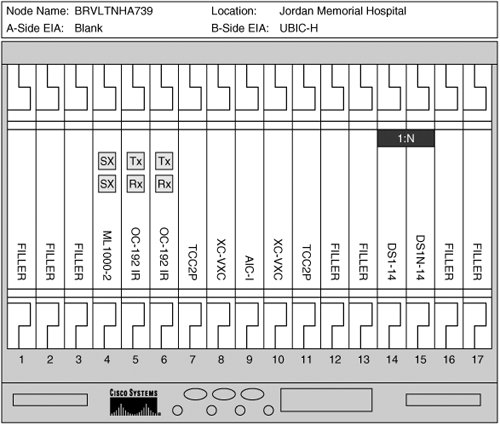 Cabling TerminationsThe UHCS DSR requires various interface types to be cabled out for interconnecting to the customer premises equipment (CPE) at UHCS locations, or for interfacing with the BrounTel or Interexchange Carrier (IXC) networks at the central office locations. Figure 6-24 shows a diagram with typical interface cabling for an ONS 15454 node location on the UHCS ring: the UHCS Headquarters node. The OC-192 ring optics will be cabled to the outside plant (OSP) fiber-termination panel using single-mode optical fibers from the SC faceplate connectors. DS1 and DS3 interface cards will be cabled to digital signal cross-connect (DSX) panels via the backplane UBIC EIA connectors. Ethernet interface cards, including the G1K-4 and ML1000-2, will be cabled to an optical splitter module panel using multimode fibers from the GBIC SC faceplate connectors (G1K-4) or the SFP LC faceplate connectors (ML1000-2). Figure 6-24. Cabling Termination Diagram, UCHS Headquarters Node Table 6-13 shows an example cabling termination assignment chart for the UHCS Headquarters location.
|
EAN: 2147483647
Pages: 140
